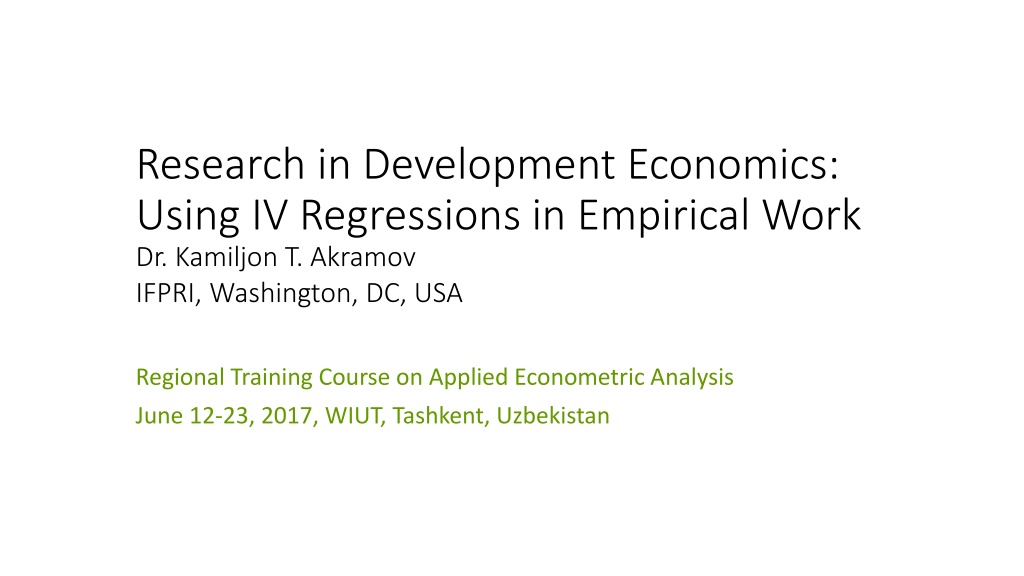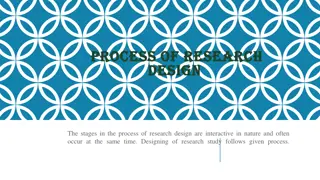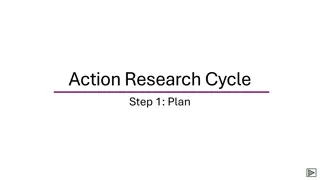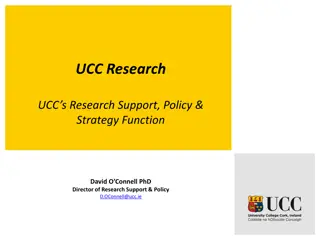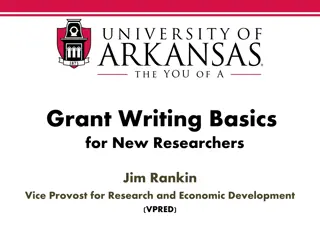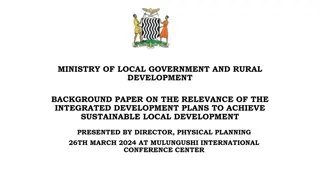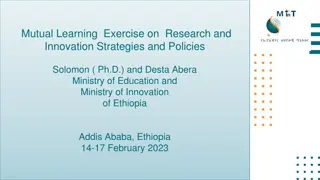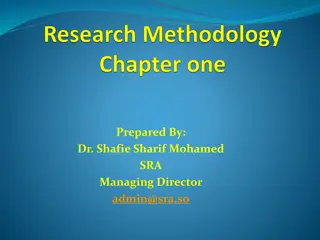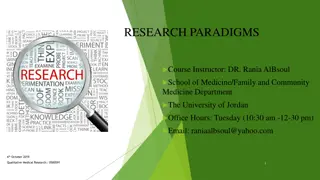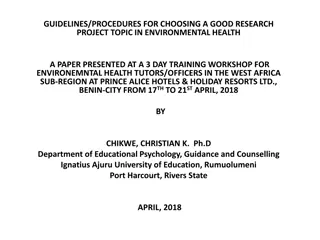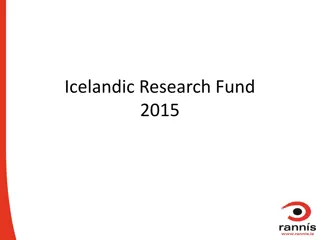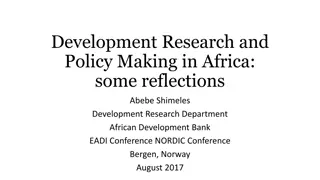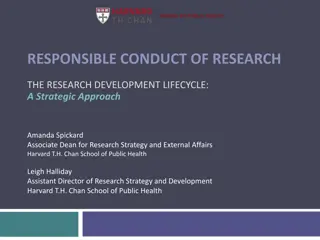IV Regression in Development Economics
This research provides insights into the use of instrumental variable (IV) regressions in development economics, addressing issues of endogeneity bias and outlining the principles and conditions for IV estimation. It covers examples related to institutions, growth, and foreign aid, highlighting the two-stage least squares (TSLS) estimator as a key method to obtain unbiased estimates in empirical work.
Download Presentation

Please find below an Image/Link to download the presentation.
The content on the website is provided AS IS for your information and personal use only. It may not be sold, licensed, or shared on other websites without obtaining consent from the author.If you encounter any issues during the download, it is possible that the publisher has removed the file from their server.
You are allowed to download the files provided on this website for personal or commercial use, subject to the condition that they are used lawfully. All files are the property of their respective owners.
The content on the website is provided AS IS for your information and personal use only. It may not be sold, licensed, or shared on other websites without obtaining consent from the author.
E N D
Presentation Transcript
Research in Development Economics: Using IV Regressions in Empirical Work Dr. Kamiljon T. Akramov IFPRI, Washington, DC, USA Regional Training Course on Applied Econometric Analysis June 12-23, 2017, WIUT, Tashkent, Uzbekistan
Outline Review of IV estimation Example 1: Institutions and growth Example 2: Foreign aid and growth
Principles of IV estimation Assume that we have an equation that can be written as follows: ??= ?1??+ ?? However, the equation suffers from endogeniety bias; accordingly, estimating this equation employing OLS will not yield an accurate estimate of the causal effect of interest Let us denote the true coefficient of interest ?0, while ?1denotes the estimated coefficient in the OLS specification
Principles of IV estimation (cont.) Now, let us assume that we have another measured variable, ??, that is correlated with ??but uncorrelated with ??, i.e., ??? ??,?? = 0 The coefficient of interest can be written as follows ???(??,??) ???(??,??) Note that this expression is only valid if the covariance of the instrument and the independent variable is different from zero In practice, instrumental variables estimates are not particularly useful if ???(??,??) is only marginally different from zero ?0=
IV conditions First, there must be a significant relationship between the instrument ??and the explanatory variable ??, i.e, ????(??,??) 0 This condition is called instrument relevance Second, the instrument must satisfy an exclusion restriction: the only reason for the relationship between ??and ??is the first stage This assumption has two parts The instrument is as good as randomly assigned (i.e., independent of potential outcomes, conditional on covariates) The instrument has no effect on outcomes other than via the first-stage channel
The IV Estimator Two stage least squares has two stages two regressions In the first stage it isolates the part of X that is uncorrelated with u by regressing X on Z using OLS Xi= 0+ 1Zi+ vi Compute predicted values of ??( ) using this regression results In the second stage regress ??on The resulting estimator is called the TSLS estimator, using OLS
Identification In IV regression, whether the coefficients are identified depends on the relation between the number of instruments (m) and the number of endogenous regressors (k) Intuitively, if there are fewer instruments than endogenous regressors, we can t estimate 1, , k The coefficients 1, , kare said to be: exactly identified if m = k overidentified if m > k underidentified if m < k
Checking Instrument Validity: Relevance First stage regression Xi= 0+ 1Z1i+ + miZmi+ m+1iW1i+ + m+kiWki+ ui The instruments are relevant if at least one of 1, , mare nonzero The instruments are said to be weak if all the 1, , mare either zero or nearly zero Weak instruments explain very little of the variation in X, beyond that explained by the W s If instruments are weak, the usual methods of inference are unreliable potentially very unreliable
Measuring Instrument Strength in Practice: The first-stage F-statistic The first stage regression (one X): regress X on Z1,..,Zm,W1, ,Wk Totally irrelevant instruments: all the coefficients on Z1, ,Zmare zero The first-stage F-statistic tests the strength of instruments in the first stage regression Rule-of-thumb: If the first stage F-statistic is less than 10, then the set of instruments is weak Weak instruments imply a small first stage F-statistic If so, the TSLS estimator will be biased, and statistical inferences (standard errors, hypothesis tests, confidence intervals) can be misleading
What to Do If You Have Weak Instruments? What to Do If You Have Weak Instruments? Find better instruments If there are many instruments, some are probably weaker than others and it s a good idea to drop the weaker ones (dropping an irrelevant instrument will increase the first-stage F) Use a different IV estimator instead of TSLS There are many IV estimators available when the coefficients are overidentified Limited information maximum likelihood (LIML) has been found to be less vulnerable to weak instruments
Checking Instrument Validity: Exogeniety Instrument exogeneity: All the instruments are uncorrelated with the error term: corr(Z1i,ui) = 0, , corr(Zmi,ui) = 0 If the instruments aren t correlated with the error term, the first stage of TSLS doesn t successfully isolate a component of X that is uncorrelated with the error term, so is correlated with u and TSLS is inconsistent If there are more instruments than endogenous regressors, it is possible to test partially for instrument exogeneity
Testing overidentifying restrictions Suppose there is one endogenous regressor and there are two valid instruments: Z1i, Z2i Then we could compute two separate 2SLS estimates Intuitively, if these 2SLS estimates are very different from each other, then something must be wrong: one or the other (or both) of the instruments must be invalid The J-test of overidentifying restrictions makes this comparison in a statistically precise way if number of Z s > number of X s (overidentified)
The The J J- -test of Overidentifying Restrictions test of Overidentifying Restrictions First estimate the equation of interest using TSLS and all m instruments Compute the predicted values , using the actual X s Compute residuals and Regress against Z1i, ,Zmi, W1i, ,Wri Compute the F-statistic testing the hypothesis that the coefficients on Z1i, ,Zmiare all zero The J-statistic is J = mF, where F = the F-statistic testing the coefficients on Z1i, ,Zmiin a regression of the TSLS residuals against Z1i, ,Zmi, W1i, ,Wri
The J-test of Overidentifying Restrictions (cont.) Under the null hypothesis that all the instruments are exogenous, J has a chi-squared distribution with m k degrees of freedom If m = k, J = 0 If some instruments are exogenous and others are endogenous, the J statistic will be large, and the null hypothesis that all instruments are exogenous will be rejected
How to find valid instruments Valid instruments are (1) relevant and (2) exogenous One general way to find instruments is to look for exogenous variation variation that is as if randomly assigned in a randomized experiment that affects X Rainfall shifts the supply curve for butter but not the demand curve; rainfall is as if randomly assigned Sales tax shifts the supply curve for cigarettes but not the demand curve; sales taxes are as if randomly assigned
Example 1: Colonial Origins of Comparative Development by Acemoglu et al. (2001) The paper starts with the fundamental question: what is the fundamental cause of large differences in income per capita across countries? Given that one plausible hypothesis is that differences in institutions and property rights lead to differences in income, how can this hypothesis be tested? The objective of the paper is to identify the impact of institutions on economic performance, and accordingly, they need a source of exogenous variation in institutions In other words, they need an instrument: a variable correlated with institutions, but otherwise uncorrelated with economic performance
Overview of identification strategy European powers set up different types of institutions under colonialism: some highly extractive, some with greater emphasis on protections against expropriation and misuse of power The type of institution chosen was influenced by the feasibility of settlement: if settler mortality was lower, there was a higher probability of better-quality institutions Better-quality institutions persist, and lead to higher economic performance in the present day Key insight: use settler mortality as an instrument for institutions
Empirical specification The primary equation of interest is the following ?????= ? + ???+ ??? where y denotes per-capita income, R is a measure of current institutions (protection against expropriation between 1985 and 1995), and X is other covariates Additional variables of interest: C is a measure of early (circa 1900) institutions, S is a measure of European settlements (fraction of population with European descent in 1900), and M is mortality rates + ??
Sources of bias in OLS regression What direction of bias would we expect in the OLS results? First, there may be measurement error in how we measure institutional quality What direction of bias will this generate? Second, institutions are endogenously determined What direction of bias will this generate?
Discussion questions: identification What direction of bias would measurement error and endogeneity, respectively, generate? Which appears to dominate? Do you find the identification strategy plausible? What are potential sources of bias? What can we observe about the strength of the first stage?
Discussion questions: interpretation This was a rock star" paper, providing seemingly rigorous evidence of a relationship between income and institutions Is this result useful? Are there policy implications? How do we interpret protection from expropriation"? Do you think this is the primary, or only, dimension of institutions that matters?
Scholarly debate The paper has been the center of an ongoing scholarly debate initiated by David Albouy from the University of Michigan Albouy argued that there were significant challenges with the settler mortality data Particularly, in a number of cases mortality rates for countries were not based on data collected within their borders, but rather imputed from countries with similar disease environments When adjustments to the mortality rate are made, the first stage has very limited predictive power (low F-statistic) The debate about the validity of AJR's empirical results continued! AJR's response
Example 2: Foreign aid and economic growth (Akramov 2012) One of the most enduring policy debates in development economics has to do with whether foreign aid increases economic growth in recipient countries Why is this important problem? Donor countries transfer billions of US$ in official development assistance (ODA) to recipient countries In 2014 donors provided a total of 131.6 billion US$ in net ODA
What is ODA? The Development Assistance Committee (DAC) defines ODA as those flows to developing and transition countries, which are: Provided by official or executive agencies of donor nations Administered with the promotion of the economic development and welfare of developing nations as its main objective Concessional in character and conveys a grant element of at least 25%, calculated at a discount rate of 10% Developmentally relevant military, peacekeeping, nuclear energy, and culture related official assistance can be included in ODA
Past studies on aid-growth relationship There is broad but contradictory literature on the aid-growth linkages Three competing strands Aid has no effect on growth and may sometimes even undermine growth in recipient countries (Mosley et al. 1987 & 1992, Boone 1994, Rajan and Subramanian 2008, etc.) Aid in all likelihood positively influences economic growth, but with diminishing returns (Hansen and Tarp 2000 and 2001, Dalgaard et al. 2004, Arndt et al. 2010) Aid has a conditional positive impact on growth (Burnside and Dollar 2000 and 2004) Strong impact on donor policy Easterly, Levine, and Roodman (2004) critique
This study Disaggregates aid into sectoral aid flows using OECD DAC classification and then estimates the impact of sectoral aid flows on economic growth Examines whether the interaction of foreign aid with the quality of governance is important for aid effectiveness Applies IV methodology by improving on and extending the most recent instrumentation strategy used in the aid effectiveness literature
Hypotheses Economic aid, which includes aid to production sectors and aid to economic infrastructure, affects economic growth by increasing domestic investment Supplement to domestic resources Substitute to domestic resources Crowding out effect and fungibility issues Possible values of coefficient: 1, <1, or>1 Aid to economic infrastructure might affect growth by improving TFP Aid to social sector may affect growth by creating additional human capital
Model specifications Analytical framework includes a system of three equations Growth equation ? = ?(??, ,???,??,????) Investment equation ??= ?(???,????,??) Human capital equation = ?(???,????,? )
Econometric estimation issues and identification Pooled cross-section and/or panel data regression methods Pooled cross-section regressions allow to examine the long-run relationship We can t rely on standard OLS because relationship between aid and growth (or income) is endogenous If countries tend to receive more aid because they are poorer or their socioeconomic conditions are deteriorating, the estimated coefficient would be biased toward zero and underestimate the impact of foreign aid If countries tend to receive less aid as their socioeconomic conditions improve, the estimated coefficient would be biased upward and overestimate the impact of aid
Econometric estimation issues and identification (cont.) The quality of governance is endogenous with respect to development If explanatory variables are systematically measured with significant error, the unobserved error term in the relationship of interest will contain the measurement error and it will be correlated with independent variables One solution to deal with above mentioned issues is IV approach
Econometric estimation issues and identification (cont.) Simultaneity bias due to joint determination of some variables in the analytical framework Possible solution Simultaneous system of equations method using 3SLS estimator
Econometric estimation issues and identification (cont.) Unobserved heterogeneity due to country-specific time invariant unobservable factors and temporal events Solution: Panel data estimation methods, which allows to control for country fixed effects and time fixed effects It is assumed that unobserved error term has a factor structure, including country-specific time-invariant component, time-specific country-invariant component, and zero-mean random component ???= ?+ ?+ ??
Econometric estimation issues and identification (cont.) Outliers Solution: robust standard errors using the Huber-White sandwich estimator Residual may include time-varying country-specific factors that affect the dependent variable Possible existence of autocorrelation within panels Possible existence of heteroskedasticity across panels (cross-sectional correlations) Solution: Panel GMM regressions Difference GMM estimator (Arrelano and Bond 1991) System GMM estimator (Blundell and Bond 1998)
Results Cross-section OLS regressions Instrumentation strategy Instrument for aid Instrument for governance (democracy) Cross-section IV regressions System of simultaneous equations Panel regressions
Instrument for aid Compelling instrumentation strategy by Rajan and Subramanian (2008) Model the supply of aid using donor-related rather than recipient-specific factors Bazzi and Clemens (2009 & 2013) critique instrument is indistinguishable from recipient s population size (correlation 0.93) Instrument is weakened by inclusion of colonizer and its interaction with population ratios in its construction (Arndt et al 2010) Instrument for aid in this study As in Rajan and Subramanian (2008) Historical relationships are captured through past colonial links and commonality of languages Influence is captured by the ratio of donor population to the recipient population Relational effects between history and influence factors: interactions between relative size and colonial links, between relative size and language traits
Instrument for aid: modifications & extensions Drop colonizer-specific variables and their interactions except the dummy for Portuguese colonies Include donor-specific fixed effects Controls for donor political and strategic interests (similarity of UN voting patterns) Relational effects between recipient size and donor political interests (interactions)
Instrument for aid: modifications & extensions (cont.) Donor commercial (trade promotion) interests ( for economic aid) Relational effects between donor size and commercial interests Controls to differentiate between types of sectoral aid flows Initial (early 1970s) values of life expectancy, fertility, access to drinking water, ratio of physicians to the population, share of agriculture in GDP, and share of rural population
Instrument for governance (democracy) The level of constraints on the executive in 1900, coded from the Polity IV database It refers to the extent of institutional constraints on the decisionmaking powers of the executive branch
Main results Aid to production sectors and economic infrastructure contributes to economic growth by increasing domestic investment One percentage point increase in the ratio of economic aid to GDP is associated with a 2.17 percentage point increase in the ratio of investment to GDP One percentage point increase in economic aid to GDP ratio increases long-run per capita growth rate by 0.27 percent Aid to social sectors doesn t appear to have a significant impact on schooling and economic growth Use pdf file to see the regression results
Data and empirical analysis Please use provided dataset and Stata do files
Discussion questions: identification Do you find the identification strategy plausible? What can we observe about the strength of the first stage? Instrument relevance Instrument exogeneity What are the potential problems?
Discussion questions: interpretation Are these results useful? Are there policy implications?
